|
< Earlier Kibitzing · PAGE 2 OF 2 ·
Later Kibitzing> |
| Mar-07-17 | | agb2002: Black has an extra pawn.
White threatens Bxf4.
The white king controls e2. Therefore, 84... Bg4+: A) 85.Kxg4 e2
A.1) 86.a6 e1=Q
A.1.a) 87.Kxf4 Qd2+ and Black will win the pawn or the the bishop with checks. For example, 88.Kg4 Qd7+ 89.Kf4 Qf7+ 89.Ke4 Qc6+ 90.Kf4 Qxa6, etc. A.1.b) 87.a7 Qg3+
A.1.b.i) 88.Kf5 Qf3 89.Bxf4 (else the black king goes to b7 and the queen tries to promote the f-pawn) 89... Qd5+ 90.Kf(g)6 (90.Kg4 or 90.Be5 lose to 90... Qd7+ and 91... Qxa7) 90... Qc6+ followed by Qc5+ or Qb7+ wins the pawn. A.1.b.ii) 88.Kh5 Qg2 89.Bxf4 Qh1+ followed by Qg1+ and Qxa7. A.2) 86.Kxf4 e1=Q 87.a6 Qd2+ transposes to A.1.a. B) 85.Kxf4 e2 86.a6 (86.Kxg4 transposes to A) 86... Bc8 87.a7 Bb7 wins. C) 85.Ke4 e2 wins.
D) 85.Kg2 f3+
D.1) 86.Kf1 Bh3+ 87.Ke1 f2+ wins.
D.2) 86.Kg1 f2+ 87.Kg2 Bh3+ followed by 88... f1=Q wins. |
|
| Mar-07-17 | | goodevans: <bcks1234: Black does not need f-pawn to win, <nasher>. After 86. a6 e1(Q) 87 a7, I think the steps are 1. Black plays Qa5...> That sounds good enough for a win but according to the tablebases (http://chessok.com/?page_id=361) black has a quicker win beginning <87...Qe4>. Either way it's a bit of a big ask for a Tuesday puzzle! |
|
Mar-07-17
 | | Dionysius1: Thanks <bcks1234>. I didn't realise a Q on its own could force a K into a corner, so that's a lesson for me!
Mind you I've just tried it out on the board and I haven't found a way to force the K to a corner because the White bishop covers some of the squares I need for the Queen Here's the set up we're looking for: White to play and Black wins
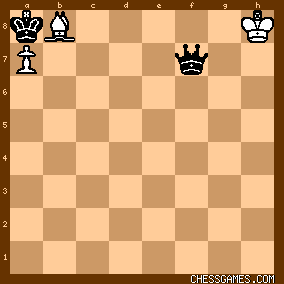
click for larger viewBut to get there Black has to force White by getting the Queen into a Knights move away from the King and at this position he can’t do that because the White Bishop controls e5. 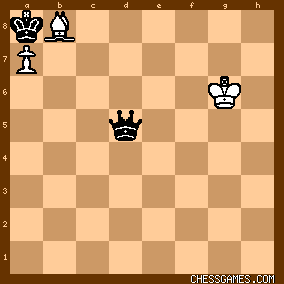
click for larger view |
|
| Mar-07-17 | | AlicesKnight: <bcks1234><Dionysius1>; Can the White K be forced into a1 instead? |
|
Mar-07-17
 | | Dionysius1: Thanks - I'll have a go. |
|
| Mar-07-17 | | zb2cr: 84. ... Bg4+ is the first important move. If White takes either the Bishop at g4 or the Pawn at f5, Black plays 85. ... e2 and Queens. If White plays 85. Kg2, the second important move is 85. ... f3+ and Black has preserved his extra Pawn. |
|
| Mar-07-17 | | whiteshark: <84...Bg4+!> inspired by <Shirov> ;) |
|
Mar-07-17
 | | Dionysius1: I don't think so. As long as the White K stays around the centre I need either d6, e5 or f4 to force him back, and that's controlled by the White B :-(. Does anyone have a machine that proves me wrong? The tablebases <goodevans> cites have a different approach altogether: 87...Qe4 88. Bxf4 and the White B never has time to get back to b8. The Q and K force the White K towards the h1 corner to deliver mate, with the Q keeping an eye on either a8 directly or a7 with some really neat forks if the White King tries to come up the board. One variation I worked out by ignoring the Nalimov surrender of the a7 pawn directly or by inviting a White fork(which just makes the win trivial) is 87...Qe4 88. Bxf4 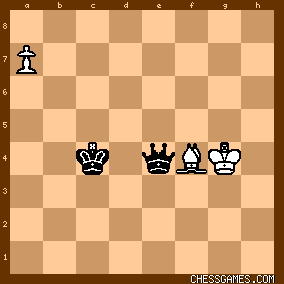
click for larger view88...Kd3 89. Kg3 Qa4 90.Bb8 Ke3 91.Kg2 Qg4+ 92. Kf1 Qf3+ 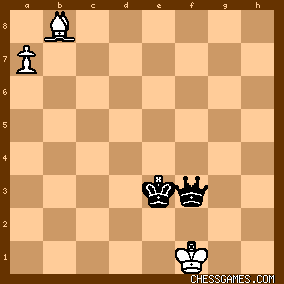
click for larger viewand black can engineer a checkmate with the Q either staying on that diagonal or checking 93. Kg1 Ke2 94. Kh2 Kf2
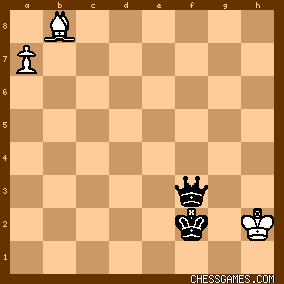
click for larger viewand now Jon Ludvig Hammer can only queen his pawn and have it taken, or succumb to mate
(95. Bg3+ Qxg3 96.Kh1 Qg2 mate) |
|
Mar-07-17
 | | Dionysius1: Sorry for the confusion - the above was in response to <AlicesKnight> "Can the White K be forced into a1 instead?". Boy, I need to be quick posting when it's the day's puzzle - earlier thoughts get separated! |
|
| Mar-07-17 | | The Kings Domain: Nice endgame puzzle and a good game. Black's dominance of the center throughout the game foretold his eventual win. |
|
| Mar-07-17 | | TheTamale: Wow, I'm really bad at playing things out in my head. I saw the move immediately, but then I thought the king could capture the pawn before it could queen. And I'm not even drunk yet. |
|
| Mar-07-17 | | Cheapo by the Dozen: I love Tuesdays! |
|
| Mar-07-17 | | beenthere240: The result is impossible because OCB games are always drawn. |
|
| Mar-07-17 | | Cheapo by the Dozen: 29 ... f2+ must have been tempting. But keeping the advanced passed pawn worked out well for Black in the game line. :) |
|
| Mar-07-17 | | Abdel Irada: ∞
<<+> Eighty-sixed on the 86th? <+>> Hmm. I think I read somewhere lately that <passed pawns must be pushed>, so the obvious solution is 84. ...e2, right? Oh. That's right. There's a king on one of the two squares from which he can stop this otherwise excellent move. Hmm. Can I find a move that chases the king off *both* of those squares? How about <84. ...Bg4+!>? White can't take on f4 or g4 without moving outside the square of the pawn and allowing it to promote; the same applies to e4. His bishop just can't get back to control e1 fast enough. This leaves the abject <85. Kg2...>, but this fails abjectly to <85. ...f3+ 86. Kf1, f2!  >. >. That little foot soldier will soon reach the promised land, even if a bishop must give its life: <87. [Any], Bh3 88. [Any], f1=Q>. (Examine the "[Any]s" and you'll see why I can say this.) ∞ |
|
| Mar-07-17 | | DrGridlock: Get that pesky White King from standing in front of the black pawns with ... Bg4+, and in the words of Queen, it's "Don't Stop Me Now" https://www.youtube.com/watch?v=Hgz... |
|
| Mar-07-17 | | YouRang: <AlicesKnight: <bcks1234><Dionysius1>; Can the White K be forced into a1 instead?> The black Q can easly push the white K against the h-file, and reach a position like this (with black to move):
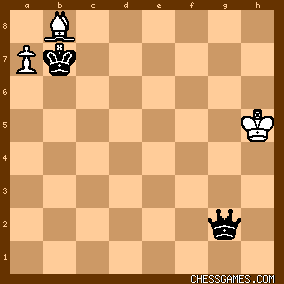
click for larger view
In order to win via zugzwang, black would like to play ...Qg3, forcing the white K toward h8 where he would be immobilized. The bishop would then have to abandon its defense of Pa7. Of course, ...Qg3 is impossible because g3 is guarded by the bishop! But that's okay! Note that the Q is able to guard a8, which frees the black K to play ...Kc8! and saunter along the light squares to (say) f5 where mate will follow. |
|
Mar-07-17
 | | Dionysius1: Great! That's quite like the principle I came up with for the mate on h1. But in the Nalimov tablebases variation I extracted, the Black King stays away from a8 and takes an active part in the threats that force the White King to h1. If I saw either in principle, I would choose the <bcks1234>/<YouRang> route. The Nalimov variation looks a lot scarier - if anything went wrong, White would queen. It's been great fun working it out with youse! |
|
Mar-07-17
 | | Peligroso Patzer: The following two posts from the first page of this thread (the first of which refers to still another post) raise a question that has not been fully answered. <Delboy: I think <domotorp> is referring to the final game position> [from which with the following additional moves:] <86. a6 f1=Q 87. a7 and> [a position results in which] <the a-pawn is protected and threatening to queen the moment black misses a check. How then does black drive the white king into a corner? White at first keeps his king next to the black pawn. Black's winning strategy surely revolves around advancing that pawn, but the win looks far from easy.> <nasher: What happens after 86. a6 e1(Q) 87 a7 ?
Black can not save his f pawn AND keep white from promoting his a pawn. It seems white may have some drawing chances.> The position in question is this (with Black to movce): 
click for larger view
Tablebases (available, for example, here: http://www.k4it.de/?topic=egtb&lang... ) confirm that the above position is winning for Black, but there is a degree of technique required. The comment by <Delboy> that the winning strategy would involve advancing the Black f-pawn is not correct, since White is able to capture that pawn without losing his own pawn, but the position can still be won by Black. One point involved in the winning technique is that the following type of position (White to move) creates zugzwang that forces White to give ground (in this specific case, forcing him to move his king to the edge of the board since the bishop check on f4 allows its capture with check to the White king): 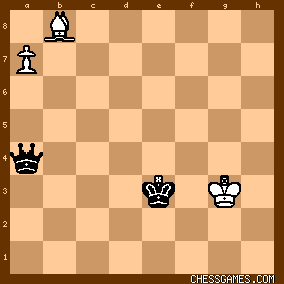
click for larger view |
|
| Mar-07-17 | | morfishine: <Peligroso Patzer> Thank you ***** |
|
| Mar-07-17 | | falso contacto: The Shirov move Bxh3 surfaced in less than a second. |
|
| Mar-07-17 | | falso contacto: It was Bh3 actually. |
|
Mar-08-17
 | | Peligroso Patzer: I am not sure of the context (especially how it relates to anything else contained in this thread) for the recent post by <falso contacto>, but I assume it refers to <47. ... Bh3> in this famous game, which involved a somewhat similar ending: Topalov vs Shirov, 1998. |
|
| Mar-08-17 | | AlicesKnight: Thanks to <YouRang> and <Dionysius1> for interesting analysis - clearly 85.fxg4? set no challenges and OTB the refusal would set practical problems. |
|
| Mar-08-17 | | bcks1234: Thanks <goodevans> <Dionysius1>, 37...Qa5 looked good, but seems like DSB ruins it! |
|
 |
|
< Earlier Kibitzing · PAGE 2 OF 2 ·
Later Kibitzing> |





